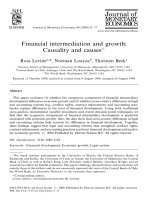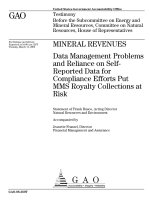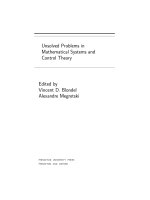Seams And Stitching Problems And Causes
Bạn đang xem bản rút gọn của tài liệu. Xem và tải ngay bản đầy đủ của tài liệu tại đây (944.26 KB, 47 trang )
Different types of Seams, Seam
Problems & their Solutions
By
Apparel
United
Introduction to Seams
A seam can be defined as : the application of a series of
stitches or stitch types to one or several layers of material.
Seams are described as :
flat
superimposed
lapped
bound
decorative
edge finishing
A seam is load bearing and should be similar in physical
properties to the material being sewn.
Flat Seams
In these seams, sometimes called Butt
Seams, two fabric edges, flat or folded,
are brought together and oversewn
with a zig-zag lockstitch, chainstitch or
covering stitch (Class 600).
Application:
The purpose is to produce a join where
no extra thickness of fabric can be
tolerated at the seam, as in underwear
or in foundation garments.
Superimposed Seams
These generally start with two or
more pieces of material
superimposed over each other and
joined near an edge, with one or
more rows of stitches. There are
various types of seams within the SS
class.
Application:
Superimposed seams is used to
create neat load bearing seams for
lingerie, shirts, etc.
Lapped Seams
•
Two or more plies of material are
lapped (i.e. with edges overlapped,
plain, or folded) and joined with one or
more rows of stitches.
Application:
Lapped seams is commonly used for
rainwear.
Lap Felled Seams
•
The Lap Felled type, involves only one
stitching operation - a strong seam with
fabric edges protected from fraying.
Application:
•
Commonly used for making up jeans or
similar garments.
Bound Seams
These are formed by folding a binding strip
over the edge of the plies of material and
joining both edges of the binding to the
material with one or more rows of stitching.
Application:
This produces a neat edge on a seam
exposed to view or to wear.
Decorative Seams
A series of stitches along a straight or
curved line or following an ornamental
design, on a single ply of material.
More complex types include various
forms of piping, producing a raised line
along the fabric surface.
Application:
This type of seam is generally used for
decorative purpose.
Edge Finishing Seams
Finishing the edge of a single ply of material
by folding it or covering it with a stitch.
The simplest of these operations is Serging,
in which a cut edge of a single ply is
reinforced by overedge stitching to neaten
and prevent fraying Includes other popular
methods of producing a neat edge like
hemming and Blind Stitch hemming.
Application:
The main purpose of this type of seam is to
produce a neat edge.
Some common seam problems,
related stitch problem
& their solutions
1. Puckering
2. Seam grin
3. Seam slippage
4. Skipped stitches
5. Unbalanced stitches
6. Uneven SPI
Skipped Stitches
Causes Solutions
Staggered Stitches
Causes Solutions
Unbalanced or Variable Stitches
SolutionsCauses
Variable Stitch Density
SolutionsCauses
Poor fabric feed control
Increase presser foot pressure
Change to a more positive feed mechanism
Seam Grin
When two pieces of fabric are pulled at right angles to the
seam, a gap is revealed between the two pieces of fabric
revealing the thread in this gap.
Corrective actions
Increase stitching tensions
Use a higher stitch rating
Seam Slippage
A fabric related issue.
Happens mainly in this types of fabric :
fabrics with low no. of warp & weft yarns.
The fabric on either side of the seam
distorts as the fabric yarns slide away
resulting in a permanent gap.
Corrective Actions
Increase seam allowance
Use a higher stitch density
Opt for a lapped fell seam
Seam Pucker
Tension pucker
Feed pucker
Shrinkage pucker
Fabric flagging
Tension Pucker
Caused by high thread tension during sewing.
More pronounced when synthetic threads are
used.
These threads on account of high stretch
properties elongate more during sewing.
After sewing the threads recover from the
stretched state pulling the fabric with it.
Remedy:
Thread tensions have to be kept as
low as possible.
Feed Pucker
Encountered when sewing very fine fabrics.
The plies of fabric tend to slip over each other
resulting in uneven feed leading to pucker.
Remedy :
Opting for advanced types of feed
systems like compound or unison feed.
Puller feed is more cost effective.
Shrinkage Pucker
Wash pucker - during the wash process the thread in the
seam shrinks, pulling the fabric with it. More so when using
cotton threads.
Ironing pucker - normally happens when synthetic threads are
used. The heat destabilizes the molecular structure of the
thread causing it to contract.
Remedy
Choosing threads with low shrinkage properties.
Fabric Flagging
A machine related issue
the throat plate aperture enlarges due to wear & tear
while sewing the needle pushes the fabric through the
aperture before penetrating the fabric
this can also happen when the needle size (thickness)
is changed and if the throat plate is not changed
accordingly.









![Báo cáo khoa học: Benzo[a]pyrene impairs b-adrenergic stimulation of adipose tissue lipolysis and causes weight gain in mice A novel molecular mechanism of toxicity for a common food pollutant doc](https://media.store123doc.com/images/document/14/rc/rp/medium_luUKRIz7Xm.jpg)